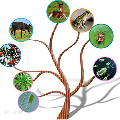Using deep learning models to diagnose cancer from histology data presents several challenges. Cancer grading and localization of regions of interest (ROIs) in these images normally relies on both image- and pixel-level labels, the latter requiring a costly annotation process. Deep weakly-supervised object localization (WSOL) methods provide different strategies for low-cost training of deep learning models. Using only image-class annotations, these methods can be trained to classify an image, and yield class activation maps (CAMs) for ROI localization. This paper provides a review of state-of-art DL methods for WSOL. We propose a taxonomy where these methods are divided into bottom-up and top-down methods according to the information flow in models. Although the latter have seen limited progress, recent bottom-up methods are currently driving much progress with deep WSOL methods. Early works focused on designing different spatial pooling functions. However, these methods reached limited localization accuracy, and unveiled a major limitation -- the under-activation of CAMs which leads to high false negative localization. Subsequent works aimed to alleviate this issue and recover complete object. Representative methods from our taxonomy are evaluated and compared in terms of classification and localization accuracy on two challenging histology datasets. Overall, the results indicate poor localization performance, particularly for generic methods that were initially designed to process natural images. Methods designed to address the challenges of histology data yielded good results. However, all methods suffer from high false positive/negative localization. Four key challenges are identified for the application of deep WSOL methods in histology -- under/over activation of CAMs, sensitivity to thresholding, and model selection.
翻译:使用深层次的学习模型来从组织学数据中诊断癌症,这带来了若干挑战。这些图像中感兴趣区域的癌症分级和本地化通常取决于图像和像素级标签,后者需要昂贵的批注过程。深层次的受监管对象本地化方法为深层次学习模型的低成本培训提供了不同的战略。仅使用图像类说明,这些方法可以用来对图像进行分类,并产生用于ROI本地化的等级启动图(CAMs)。本文审查了WSOL的最新DL方法(ROIs)。我们建议了一种分类方法,根据模型的信息流将这些方法分为自下至上和自上至下的方法。虽然后者进展有限,但最近的自下而上的方法正在推动深层次的学习模型模型模型模型模型模型模型培训。这些方法达到了本地化模型的精确度,并揭示了一个主要的限制。 CAM 最初的初始化方法导致从错误的本地化的本地化方法(DLUF),随后的工作目的是根据模型向下划分的自下和自上层数据流分析结果。C先生的精度评估了高层次方法。</s>



